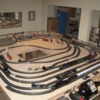About a month ago I posted my experience with adding Legacy/TMCC control to my vintage Gilbert track/switch layout. https://ogrforum.ogaugerr.com/...ntage-gilbert-layout. That was an error-free transition from conventional AC transformer control to Command Base 990 and remote control. My layout is described in two attachments in that mid-November post. I am running a Legacy, a TMCC, and a FlyerChief engine on the layout with the Command Base 990 + remote.
I also have two MTH F3 Protosound diesels that I've been running via conventional AC transformer control. I like these diesels ... good looking/sounding plus heavy so run well on my 60+ year-old Gilbert tubular track and Gilbert 720A switches. Have been studying ins and outs of adding DCS to run them at a steady 17-18 volts via remote control. Lots on O-gauge forums. Haven't found much on S-gauge forums. But did find a nice 2017 summary of Chuck K's S-gauge experience implementing DCS. https://ogrforum.ogaugerr.com/...ines-via-the-mth-app. I commented on that series of posts last week and asked Chuck some more on his S-gauge experience. With that positive feedback, I opted to try my hand at DCS on my vintage Gilbert track and Gilbert 720A switches along with retaining concurrent control of my Legacy/TMCC locos on the same layout.
I opted to go with DCS Explorer to see if DCS would work ok on my layout. That was a less costly way to try it out versus going the full DCS suite of TIU and Remote. I've read Barry B's DCS books, trolled the internet, plus I've been communicating with Ray of Ray's Electric Train works and ordered the DCS Explorer from him after more discussion about adapting it to my layout usage. I'm ok with the Explorer's limitations compared to the full DCS suite; it does give me the ability to run all of my locos at 17-18 volts with individual loco control for the respective engine remotes: Legacy/TMCC = handheld Lionel remote; FlyerChief = hand held bluetooth remote; DCS Protosound 3.0 = smart device with MTH app. That's all ok to me. Plus I'll continue to run my conventional PW locos via Z4000 throttle whenever that need arises.
The biggest limitation (to me) of the DCS Explorer is its 5 amp current limitation. So before going with it, I double-checked my three loop operations for current draw using the digital display on my Z4000. Typical current draw has been running ~2 - 2.5 amps with increase to 3 amps total when operating horn/whistle for three locos and freight cars with one loco pulling some incandescent-lighted passenger cars. I already have a 5 amp quick blow fuse wired inbetween my Z4000 and my Atlas 215 SPDT switch array; I’ll let it there. That fuse does blow quickly when I have a derailment like crossing into a Gilbert switch that’s in the wrong position ... have done that a few times. I believe that retaining my 5 amp quick blow fuse between Z4000 and DCS Explorer will cause my inline fuse to blow before the DCS Explorer 5 amp fuse which is my preference. I have a bunch of spare 5 amp quick blow fuses for such derailments. I could use a 4 amp inline fuse to avoid blowing the DCS Explorer fuse. Will figure that out later. My track layout has operated fine with my current 5 amp inline quick blow fuse for up to 3 trains with incandescent-lighted passenger cars and or freight cars. So, it appears that the 5 amp current limitation is workable for my train usage.
So, yesterday, I wired the DCS Explorer into my layout and included a DPDT switch to either run track power through the DCS Explorer or to bypass the DCS Explorer if I know I'll have an especially high current draw on non-Protosound 3.0 locos in the future. Plus, downstream of the DCS Explorer my power goes to/through my Atlas SPDT switch array so I can wheel power to any/all of my three track loops to manage track power as well. Upon powering the DCS Explorer with 17 volts Z4000 input power, the Explorer went through its startup sequence. I turned on my iPad and it found and locked on to the DCS Explorer wifi signal and then I went into the DCS app and it found my two Protosound 3.0 engines and I added them to my DCS. Then I ran them singly and together with bell/horn/throttle control from the iPad app on one, then two, then all three of my track loops with Gilbert 720A switching back and forth between loops. No hiccups. Then I fired up a TMCC steamer on a 3rd track loop and noted no interference in control of that from the Legacy Command base remote or to the Protosound 3.0 locos on the iPad app. Today I ran one of the Protosound 3.0 locos on the same loop as a Legacy loco under their respective controls ... all worked ok. I also ran one of the Protosound 3.0 locos through my two reversing loops today without hiccup using the iPad app.
So, It appears that 1) DCS does indeed get its signal around my loops and reverse loops without issue, and 2) the DCS Explorer is able to provide sufficient DCS signal for my layout, and 3) I have adequate DCS control of Protosound 3.0 locos concurrent with operating my Legacy/TMCC locos.
Great!
Regards,
Tom





